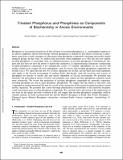| dc.contributor.author | Bains, William | |
| dc.contributor.author | Petkowski, Janusz | |
| dc.contributor.author | Sousa-Silva, Clara | |
| dc.contributor.author | Seager, Sara | |
| dc.date.accessioned | 2020-04-14T14:09:52Z | |
| dc.date.available | 2020-04-14T14:09:52Z | |
| dc.date.issued | 2019-07 | |
| dc.identifier.issn | 1531-1074 | |
| dc.identifier.uri | https://hdl.handle.net/1721.1/124611 | |
| dc.description.abstract | Phosphorus is an essential element for all life on Earth, yet trivalent phosphorus (e.g., in phosphines) appears to be almost completely absent from biology. Instead phosphorus is utilized by life almost exclusively as phosphate, apart from a small contingent of other pentavalent phosphorus compounds containing structurally similar chemical groups. In this work, we address four previously stated arguments as to why life does not explore trivalent phosphorus: (1) precedent (lack of confirmed instances of trivalent phosphorus in biochemicals suggests that life does not have the means to exploit this chemistry), (2) thermodynamic limitations (synthesizing trivalent phosphorus compounds is too energetically costly), (3) stability (phosphines are too reactive and readily oxidize in an oxygen (O2)-rich atmosphere), and (4) toxicity (the trivalent phosphorus compounds are broadly toxic). We argue that the first two of these arguments are invalid, and the third and fourth arguments only apply to the O2-rich environment of modern Earth. Specifically, both the reactivity and toxicity of phosphines are specific to aerobic life and strictly dependent on O2-rich environment. We postulate that anaerobic life persisting in anoxic (O2-free) environments may exploit trivalent phosphorus chemistry much more extensively. We review the production of trivalent phosphorus compounds by anaerobic organisms, including phosphine gas and an alkyl phosphine, phospholane. We suggest that the failure to find more such compounds in modern terrestrial life may be a result of the strong bias of the search for natural products toward aerobic organisms. We postulate that a more thorough identification of metabolites of the anaerobic biosphere could reveal many more trivalent phosphorus compounds. We conclude with a discussion of the implications of our work for the origin and early evolution of life, and suggest that trivalent phosphorus compounds could be valuable markers for both extraterrestrial life and the Shadow Biosphere on Earth. ©2019 | en_US |
| dc.description.sponsorship | MIT Amar G. Bose Research Grant | en_US |
| dc.language.iso | en | |
| dc.publisher | Mary Ann Liebert Inc | en_US |
| dc.relation.isversionof | 10.1089/AST.2018.1958 | en_US |
| dc.rights | Article is made available in accordance with the publisher's policy and may be subject to US copyright law. Please refer to the publisher's site for terms of use. | en_US |
| dc.source | Mary Ann Liebert | en_US |
| dc.title | Trivalent phosphorus and phosphines as components of biochemistry in anoxic environments | en_US |
| dc.type | Article | en_US |
| dc.identifier.citation | Bains, William, Janusz Petkowski, Clara Sousa-Silva, and Sara Seager, "Trivalent phosphorus and phosphines as components of biochemistry in anoxic environments." Astrobiology 19, 7 (July 2019): p. 885-902 doi 10.1089/AST.2018.1958 ©2019 Author(s) | en_US |
| dc.contributor.department | Massachusetts Institute of Technology. Department of Earth, Atmospheric, and Planetary Sciences | en_US |
| dc.relation.journal | Astrobiology | en_US |
| dc.eprint.version | Final published version | en_US |
| dc.type.uri | http://purl.org/eprint/type/JournalArticle | en_US |
| eprint.status | http://purl.org/eprint/status/PeerReviewed | en_US |
| dc.date.updated | 2020-04-07T14:19:10Z | |
| dspace.date.submission | 2020-04-07T14:19:12Z | |
| mit.journal.volume | 19 | en_US |
| mit.journal.issue | 7 | en_US |
| mit.license | PUBLISHER_POLICY | |
| mit.metadata.status | Complete | |
